Somalia is having Oil Conference in London. They say they won’t allow bidding during the event anymore but will only present new oil data. Why inst the Somali Government interested in Natural Gas. Below we have data from Canadian government on natural Gas.
What is natural gas?
Natural gas is a naturally occurring hydrocarbon composed primarily of methane, though it may also contain varying amounts of natural gas liquids (ethane, propane, butane, and pentane) and non-energy components.
Natural gas industry
The upstream gas industry is made up of several hundred companies that engage in activities such as exploration, drilling, and production of raw natural gas. Some upstream companies also own and operate gathering pipelines and field processing facilities.
The midstream natural gas industry operates natural gas processing plants, which remove impurities and natural gas liquids (NGL), natural gas storage facilities, gathering pipelines, and NGL facilities.
The downstream natural gas industry is made up of long haul transmission pipelines and distribution companies, also called local distribution companies (LDCs). LDCs receive gas from pipelines and then distribute it to consumers via extensive networks of local distribution pipelines.
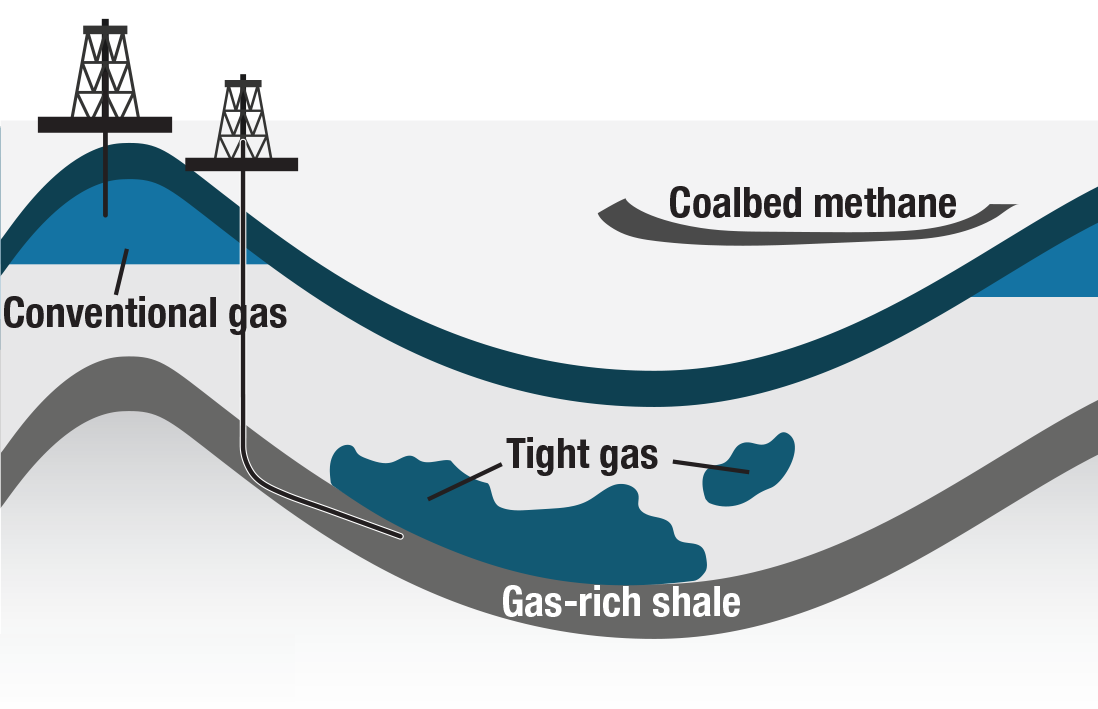
Text version
International context
Find out how Canada’s natural gas ranks on an international scale:
| Rank | Country | Percentage of Total |
|---|---|---|
| 1 | United States | 20% |
| 2 | Russia | 18% |
| 3 | Iran | 6% |
| 4 | Canada | 5% |
| 5 | Qatar | 4% |
Canada-U.S. resources
Proved reserves are when natural gas is known to exist and is recoverable under current technological and economic conditions. At the end of 2016, Canada and the U.S had a total of 414 trillion cubic feet (Tcf) of proved reserves of natural gas (Canada: 73 Tcf, U.S.: 341 Tcf).
Marketable and technically recoverable resources
Canadian marketable resources refers to natural gas that is in a marketable condition, after the removal of impurities and after accounting for any volumes used to fuel surface facilities. Marketable resources are recoverable using existing technologies, based on geological information, but much of the drilling necessary to produce the natural gas has not yet been performed.

Text version
U.S. technically recoverable resources refers to natural gas that is estimated to be recoverable as drilling and infrastructure expands (similar to Canadian marketable resources).
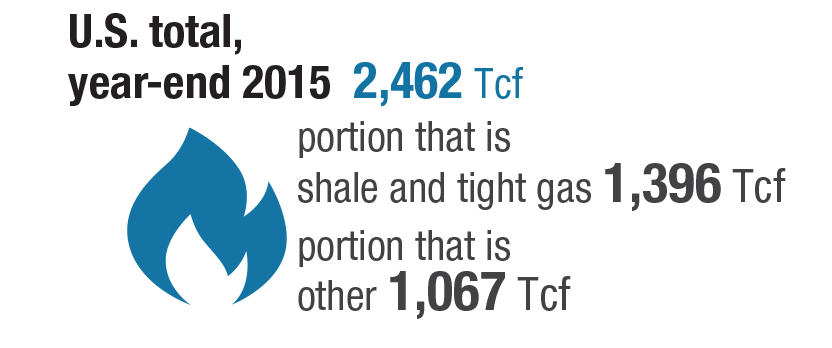
Text version
Canada-U.S. market
Canada’s natural gas market is heavily integrated with those of the U.S. largely due to the location of supply basins, demand centres, and the availability of transportation infrastructure, as well as existing Canada – U.S. trade agreements. These factors allow for consumers and distributors on either side of the border to freely access natural gas from the lowest cost supplier.
In 2017, Canada-U.S. production in the natural gas industry reached 90.3 billion cubic feet per day (Bcf/d) or 2.6 billion cubic metres per day (Bcm/d).
- Canadian average marketable production: 16.1 Bcf/d (0.5 Bcm/d)
- Conventional: 20%
- Unconventional*: 80%
- U.S. average marketable production: 74.2 Bcf/d (2.1 Bcm/d)
- Conventional: 23%
- unconventional*: 77%
- LNG imports of North American countries:
- Canada: 0.04 Bcf/d
- U.S.: 0.21 Bcf/d
- Mexico: 0.66 Bcf/d
- LNG exports of North American countries:
- U.S.: 1.74 Bcf/d
* Unconventional gas includes tight gas, coalbed methane and shale gas
Natural gas wells
While Canadian natural gas production remained relatively flat and the number of wells drilled declined, the well productivity has increased over time. This reflects the increased use of horizontal drilling and increased well length.
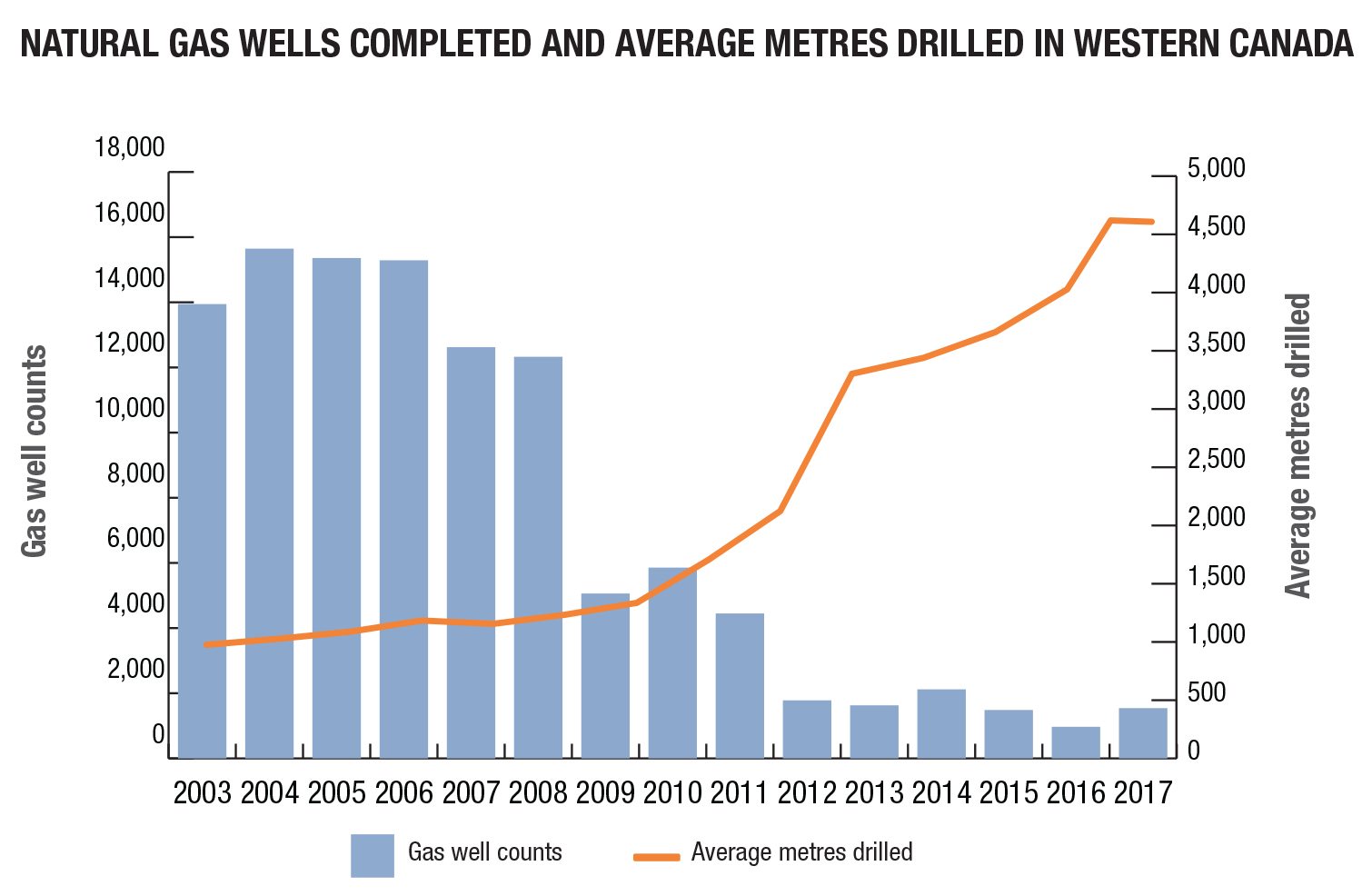
Text version

Text version
Marketable production by province
In 2017, Alberta produced 72% of the marketable natural gas in Canada. 97% of all natural gas produced in Canada is from the western-most provinces while over 70% of population lives east of Manitoba.
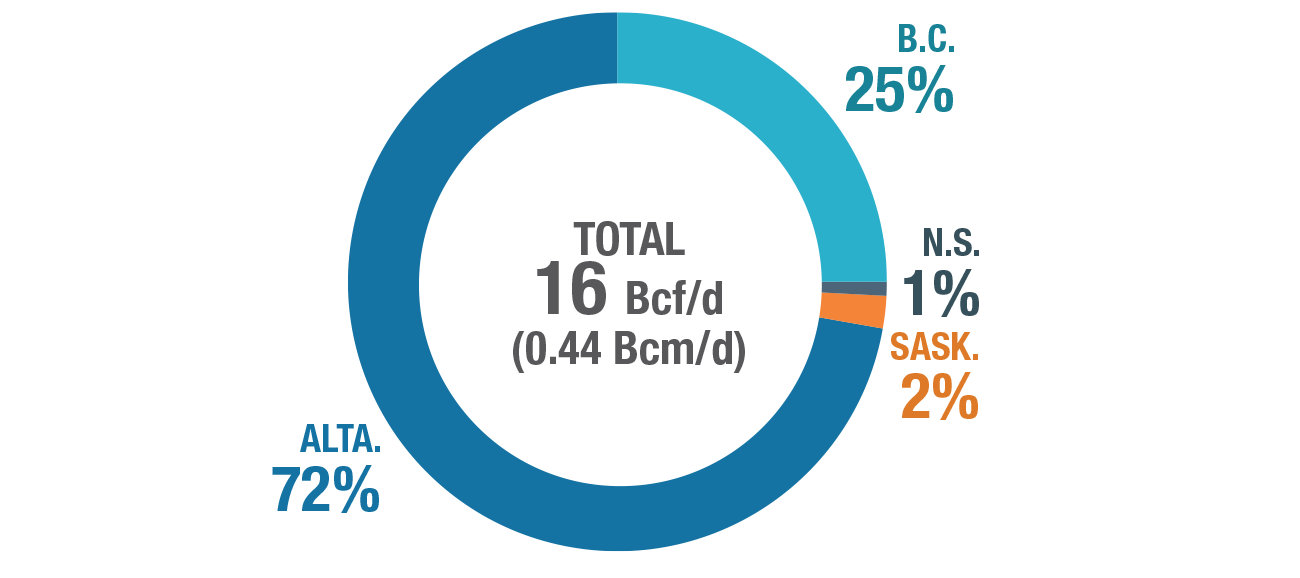
Text version
Trade

Text version
Exports
While the share of exports is declining, more Canadian gas was exported than consumed domestically. In 2017, Canada exported 8.2 Bcf/d (0.23 Bcm/d) of natural gas.
Canadian natural gas exports to the Western U.S. and U.S. Midwest remain important.
Key facts
- 51% of Canadian production is exported
- All Canadian exports go to the U.S.
- The value of Canadian net exports (exports minus imports) was $6.7 billion in 2017.
Imports
In 2017, Canada imported 2.4 Bcf/d (0.07 Bcm/d) of natural gas.
Natural gas imports from the U.S. into eastern Canada are on the rise, due to higher supplies in the U.S. Northeast and shorter transportation distances from these U.S. natural gas basins.
Key facts
- 97% of U.S. imports and 11% of U.S. consumption come from Canada
- 98% of Canada’s imports and 20% of Canadian consumption comes from the U.S.
- Since 2009, Canada has also imported small amounts of liquefied natural gas from other countries through the Canaport LNG terminal in Saint John, N.B.
Upstream prices
The AECO hub is Canada’s largest natural gas trading hub and the AECO price serves as a benchmark for Alberta wholesale natural gas transactions.
| Average 2007 – 2016 | $4.18/MMbtu |
| Average 2015 | $2.70/MMbtu |
| Average 2016 | $2.18/MMbtu |
| Average 2017 | $2.20/MMbtu |
| Average: 2018 (first four months) | $1.88/MMbtu |
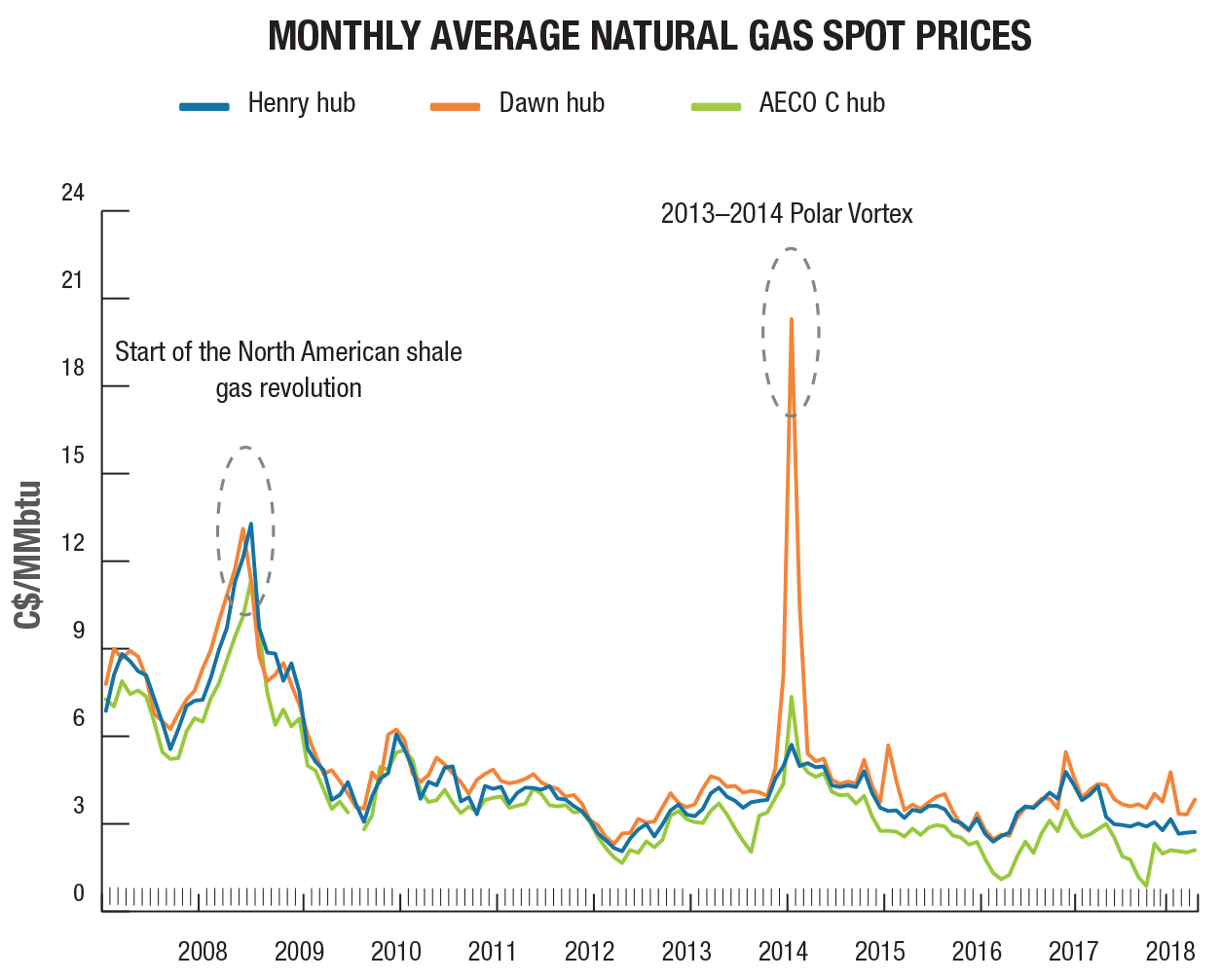
Text version
Shale and tight gas
Shale is ultra-low permeability sedimentary rock containing natural gas. The gas is extracted by using horizontal drilling and hydraulic fracturing.
Hydraulic fracturing (or fracking) creates fractures in sedimentary rock formations by using pressurized water, mixed with small amounts of sand and additives, to release the natural gas.
Potential in Canada
Shale gas resources are found in British Columbia, Alberta, Saskatchewan, Manitoba, Ontario, Quebec, New Brunswick, Nova Scotia and the territories.
Technological advancements in drilling (long-reach horizontal well bores) and completion techniques (multistage hydraulic fracturing) have enabled the commercial production of shale gas. These advancements have increased the long-term prospects for the supply of natural gas in North America.
Learn more about the exploration and production of shale and tight resources in Canada.
Transportation
Natural gas is mainly transported within extensive networks of pipelines from natural gas wells to processing plants to Canadian customers and distribution companies. There are a variety of key existing pipelines that transport natural gas across the country.
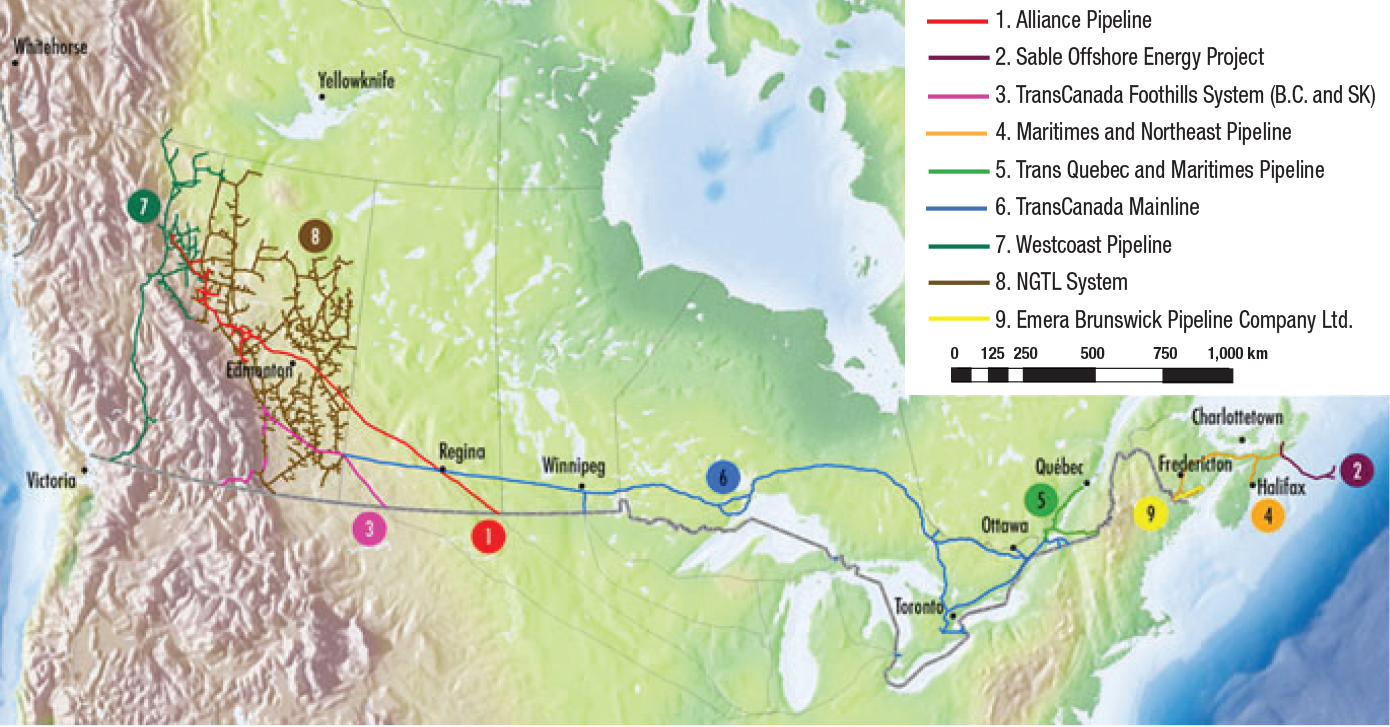
Text version
Enbridge Inc
Enbridge is a North American leader in gathering, transportation, processing, and storage of natural gas. Some of the pipelines that are a part of this network include:
- Maritimes & Northeast Pipeline: Nova Scotia and New Brunswick to the U.S.
- Union Gas: gas distribution and transmission in Ontario and eastern U.S.
- West Coast Energy: a pipeline in British Columbia
- Enbridge Gas Distribution: largest local gas distribution company in Canada
- Alliance Line (50% owner): British Columbia through Alberta; and Saskatchewan to Chicago
- Vector Line (60% owner): Chicago to Ontario
TransCanada Pipelines
TransCanada is a leading natural gas pipeline company serving markets in Canada, the U.S., and Mexico, tapping into virtually all natural gas basins in North America. Some of TransCanada’s key pipelines include:
- Nova Gas Transmission Ltd (NGTL) System: serving Alberta and British Columbia
- Canadian Mainline: several pipelines in the same corridor from the Alberta/Saskatchewan border to Quebec (city) with several interconnections to the U.S. along the way
- Foothills: from Alberta to Idaho via British Columbia and from Alberta to Montana via Saskatchewan
ATCO Pipeline
- Gathering and distribution lines within Alberta
TransGas Ltd.
- Gathering, transmission and storage facilities in Saskatchewan
- Owned by SaskEnergy Inc. (provincial distributer)
Natural gas energy use
The total natural gas energy use in Canada in 2015 was 2,754 petajoules (PJ). Natural gas has many different applicationsfrom heating to generating electricity to acting as an alternative fuel. It is used extensively in the residential, commercial, industrial, transportation and agricultural sectors.
| Sector | Energy use (petajoule) | Energy use (bcf/d) | % of total |
|---|---|---|---|
| Residential | 689.8 | 1.71 | 25% |
| Commercial | 512.9 | 1.27 | 18.6% |
| Industrial | 1,508.1 | 3.74 | 54.8% |
| Transportation | 3.9 | 0.01 | 0.1% |
| Agriculture | 39.1 | 0.1 | 1.4% |
| Total | 2,753.8 | 6.83 | 100% |
Natural gas is primarily used by provinces for electricity generation and heating of space and water in buildings. Provinces with access to large amounts of hydro power electricity like Quebec tend to use less natural gas than others.
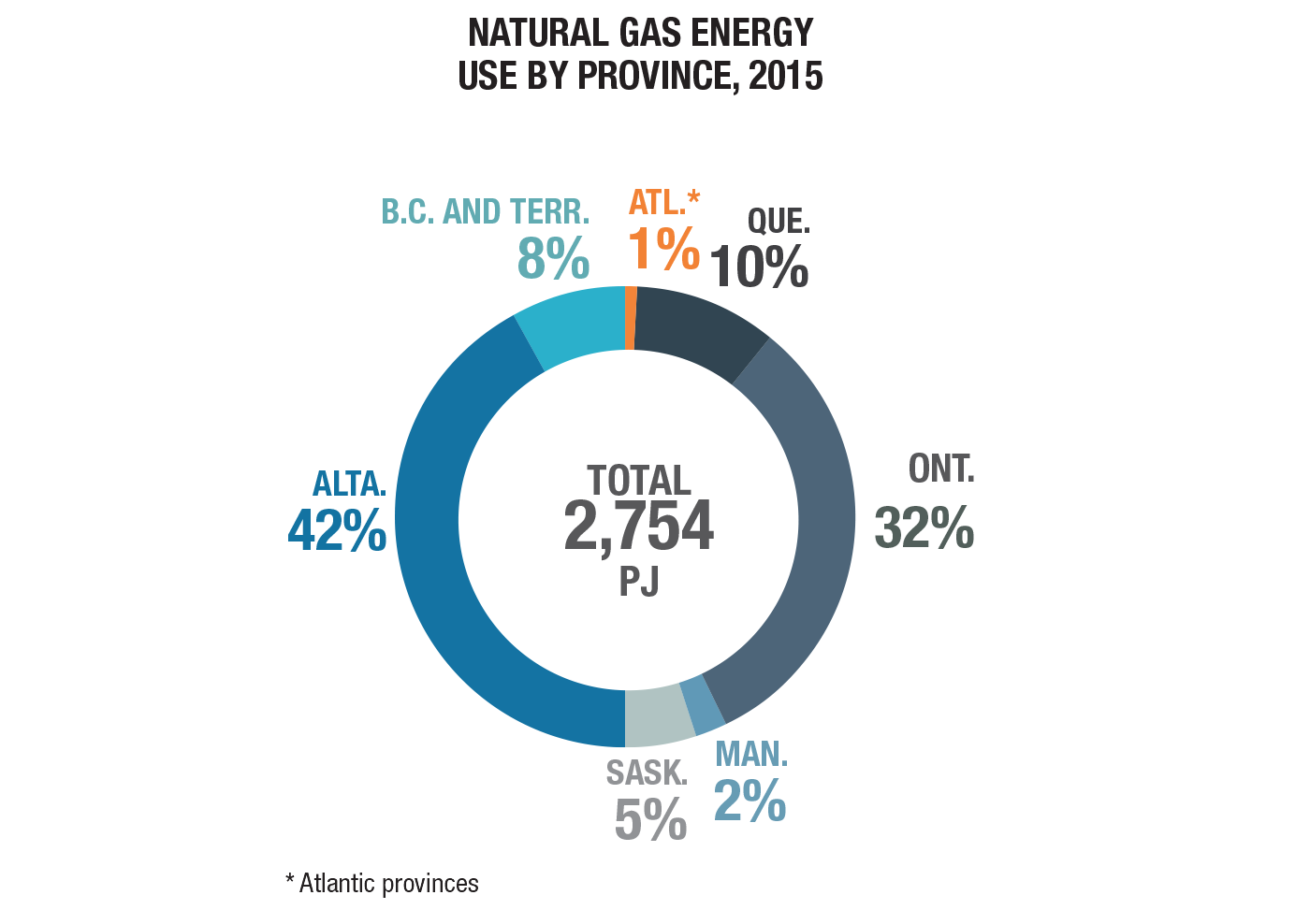

Leave a Reply